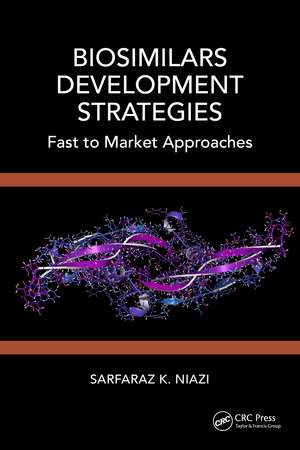Biosimilars Development Strategies: Fast to Market Approaches
Autor Sarfaraz K. Niazien Limba Engleză Hardback – 31 iul 2024
Features:
- Describes the emergence of biosimilars since the first publication of the recombinant engineering patent, as well as a listing of all approved recombinant products, their patent expiry and their adoption across the globe.
- Provides a better understanding of the safety and efficacy of approved biosimilars.
- Global approval requires accommodating guidelines and detailed planning to avoid redundancy as well as high costs. The basic expectations of the agencies are presented here.
- Presents a detailed analysis of all EU and FDA-approved products with a comparative analysis.
- Renowned author and entrepreneur in the field of drug discovery and production.
Preț: 906.52 lei
Preț vechi: 954.23 lei
-5% Nou
Puncte Express: 1360
Preț estimativ în valută:
173.46€ • 189.01$ • 146.17£
173.46€ • 189.01$ • 146.17£
Carte tipărită la comandă
Livrare economică 23 aprilie-07 mai
Preluare comenzi: 021 569.72.76
Specificații
ISBN-13: 9781032517018
ISBN-10: 1032517018
Pagini: 198
Ilustrații: 36
Dimensiuni: 156 x 234 mm
Greutate: 0.45 kg
Ediția:1
Editura: CRC Press
Colecția CRC Press
Locul publicării:Boca Raton, United States
ISBN-10: 1032517018
Pagini: 198
Ilustrații: 36
Dimensiuni: 156 x 234 mm
Greutate: 0.45 kg
Ediția:1
Editura: CRC Press
Colecția CRC Press
Locul publicării:Boca Raton, United States
Public țintă
Academic, Postgraduate, Professional Practice & Development, and Undergraduate AdvancedCuprins
Preface
Chapter 1 All About Biosimilars
1. Introduction
2. Approvals
3. Future Candidates
4. Approval Guidelines
5. Waivers
6. Appendix: Terminology
7. Appendix 2: Therapeutic Proteins approved by the FDA: potential biosimilar candidates.
8. Bibliography
Chapter 2 Product Type and Selection Strategies
1. Background
2. Exclusivity
3. Formulation
4. Route of Administration
5. Reference Product
Chapter 3 Development Master Plan
1. Introduction
2. Creating a Plan
3. Intellectual Property
4. Expression System
5. Release Specification
6. Nonclinical Testing
7. Clinical Pharmacology Assessment
8. Clinical Immunogenicity Assessment
9. Clinical Efficacy Assessment
10. Extrapolation of Clinical Data Across Indications
11. Interchangeability and Substitution
Chapter 4 Optimization of Cost of Goods
1. Background
2. Creation of Cell Lines
3. Media
4. Containers and Mixing Systems
5. Working downstream
6. Regulatory
7. Ongoing Production
8. Continuous Manufacturing
Chapter 5 Strategic Understanding for Biosimilars Future
1. Introduction
2. The Role of the US Congress
3. The Role of the FDA
4. The Role of Developers
5. The Role of the Associations
6. Conclusions
Chapter 6 Repurposing Biosimilars
1. Introduction
2. Understanding Therapeutic Proteins
3. Reinvention Scope
4. Intellectual Property
5. Artificial Intelligence (AI) and Machine Learning (ML)
6. Structure Prediction
7. Target identification
8. Molecular Docking
9. Drug Conjugates
10. Regulatory Perspective
11. Conclusions
12. References
Chapter 1 All About Biosimilars
1. Introduction
2. Approvals
3. Future Candidates
4. Approval Guidelines
5. Waivers
6. Appendix: Terminology
7. Appendix 2: Therapeutic Proteins approved by the FDA: potential biosimilar candidates.
8. Bibliography
Chapter 2 Product Type and Selection Strategies
1. Background
2. Exclusivity
3. Formulation
4. Route of Administration
5. Reference Product
Chapter 3 Development Master Plan
1. Introduction
2. Creating a Plan
3. Intellectual Property
4. Expression System
5. Release Specification
6. Nonclinical Testing
7. Clinical Pharmacology Assessment
8. Clinical Immunogenicity Assessment
9. Clinical Efficacy Assessment
10. Extrapolation of Clinical Data Across Indications
11. Interchangeability and Substitution
Chapter 4 Optimization of Cost of Goods
1. Background
2. Creation of Cell Lines
3. Media
4. Containers and Mixing Systems
5. Working downstream
6. Regulatory
7. Ongoing Production
8. Continuous Manufacturing
Chapter 5 Strategic Understanding for Biosimilars Future
1. Introduction
2. The Role of the US Congress
3. The Role of the FDA
4. The Role of Developers
5. The Role of the Associations
6. Conclusions
Chapter 6 Repurposing Biosimilars
1. Introduction
2. Understanding Therapeutic Proteins
3. Reinvention Scope
4. Intellectual Property
5. Artificial Intelligence (AI) and Machine Learning (ML)
6. Structure Prediction
7. Target identification
8. Molecular Docking
9. Drug Conjugates
10. Regulatory Perspective
11. Conclusions
12. References
Notă biografică
Sarfaraz K Niazi, Ph.D., is an Adjunct Professor at the University of Illinois. He has authored 60+ major books, 100+ research papers, and 100+ patents, mainly in bioprocessing. He has hands-on experience establishing biopharmaceutical projects, from concept to market, including setting up the first biosimilar company in the US and leading to several FDA approvals. He serves as an advisor to several regulatory agencies, including the FDA.
Descriere
Provides an update on the status of biosimilars and a perspective for the next decade. How biosimilars are developed in the future will include many AI-based features to establish structural similarity that will prevent the need for most other testing, including detailed analytical assessment and clinical pharmacology testing.
